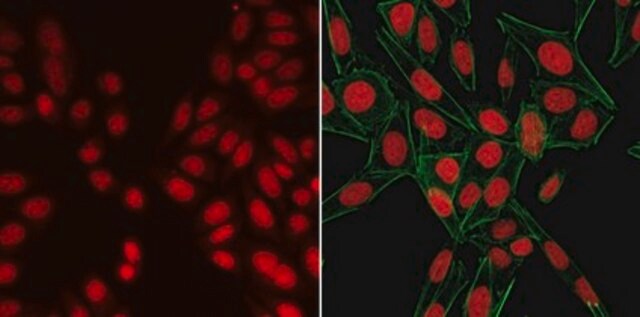推薦產品
生物源
mouse
品質等級
共軛
unconjugated
抗體表格
purified from hybridoma cell culture
抗體產品種類
primary antibodies
無性繁殖
DX2, monoclonal
描述
fluorescence intensity and maximum percentage positive similar to that obtained with saturating antibody levels
形狀
buffered aqueous solution
用途
10 μL sufficient for 1 × 106 cells
物種活性
human
技術
flow cytometry: 4-20 μg/mL using cultured human Burkitt’s lymphoma Raji cells
microarray: suitable
同型
IgG1
UniProt登錄號
運輸包裝
dry ice
儲存溫度
−20°C
目標翻譯後修改
unmodified
基因資訊
human ... FAS(355)
一般說明
Monoclonal Anti-Human Fas (CD95/Apo-1) (mouse IgG1 isotype) is derived from the DX2 hybridoma produced by the fusion of mouse myeloma cells and splenocytes from C3H mice immunized with murine L cells transfected by a human Fas/CD95 cDNA. CD95/Fas/Apo-1 exhibits strong homologies with the extracellular domain of receptors belonging to the tumor necrosis factor (TNF) receptor family, which includes TNF receptor types 1 and 2 (TNFR1/2), the low affinity nerve growth factor receptor, and lymphocyte receptors such as CD27, CD30, CD40, and OX40. Fas is an integral membrane protein, with strong homology to TNF-α and -β , has been identified as Fas ligand.
Many cells can be activated to undergo apoptosis following the interaction of selected ligands with cell surface receptors. The most well studied receptors are CD95/Fas/Apo-1 (apoptosis inducing protein 1) and tumor necrosis factor receptor 1 (TNFR1). Apoptosis mediated by either of these results in activation of the caspases. However, Fas-mediated death occurs much more rapidly than that triggered by TNFR1. Human Fas/CD95/Apo-1 is a single transmembrane glycoprotein receptor (325 amino acids, 45-48 kDa).
特異性
Reacts specifically with the functional epitope of human Fas (CD95/Apo-1) antigen. By immunoblotting, the clone recognizes denatured, non-reduced recombinant human Fas (amino acid residues 1-173). The antibody is reactive in flow cytometry, and may be reactive in the induction of apoptosis.
免疫原
murine L cells transfected with a human Fas/CD95 cDNA.
應用
Applications in which this antibody has been used successfully, and the associated peer-reviewed papers, are given below.
Western Blotting (1 paper)
Western Blotting (1 paper)
Monoclonal Anti-Fas (CD95/Apo-1) antibody is suitable for apoptosis treatment of Jurkat cells to study the contribution of channel type into the net K+ flux. It is also suitable for flow cytometry at a concentration of 4-20μg/mL using cultured human Burkitt′s lymphoma Raji cells.
Monoclonal Anti-Fas (CD95/Apo-1) antibody produced in mouse has been used in:
- immunoblotting
- flow cytometry
- the induction of apoptosis
生化/生理作用
Fas is expressed in a number of lymphoma cell lines, on Epstein-Barr virus-transformed B lymphoblasts and on a proportion of activated B and T cells. Fas is also detected in soluble form and this form of the protein is thought to play a role in regulating certain aspects of immune system function. Elevated levels of soluble Fas is observed in leukemia and systemic lupus erythematosus. Therefore, altered levels of secreted Fas protein is likely to be involved in the abnormal growth regulation of lymphoid cells.
Human CD95/Fas/Apo-1 antigen is a single transmembrane glycoprotein receptor of 325 amino acids (45-48 kDa) which activate cell apoptosis. The action of Fas is mediated via FADD (Fas-associated death domain)/ MORT1, an adapter protein that has a death domain at its C-terminus and binds to the cytoplasmic death domain of Fas. APO-1/Fas(CD95) comprises of a death domain (DD) within the cytoplasmic region which triggers apoptosis upon binding of their cognate ligands. Once it is activated, APO-1/Fas(CD95) further aggregates its intracellular death domains which leads to the recruitment of two key signaling proteins followed by the formation of death-inducing signaling complex. These complex crosslinks through its C-terminal DD with APO-1/Fas receptors and engage caspase-8 via its N-terminal death effector domain (DED) to the DISC.
外觀
Solution from a bioreactor culture supernatant in 0.01 M phosphate buffered saline, pH 7.4, containing 15 mM sodium azide.
免責聲明
Unless otherwise stated in our catalog or other company documentation accompanying the product(s), our products are intended for research use only and are not to be used for any other purpose, which includes but is not limited to, unauthorized commercial uses, in vitro diagnostic uses, ex vivo or in vivo therapeutic uses or any type of consumption or application to humans or animals.
未找到適合的產品?
試用我們的產品選擇工具.
儲存類別代碼
10 - Combustible liquids
水污染物質分類(WGK)
WGK 3
閃點(°F)
Not applicable
閃點(°C)
Not applicable
個人防護裝備
Eyeshields, Gloves, multi-purpose combination respirator cartridge (US)
分析證明 (COA)
輸入產品批次/批號來搜索 分析證明 (COA)。在產品’s標籤上找到批次和批號,寫有 ‘Lot’或‘Batch’.。
Georgina Valencia-Cruz et al.
American journal of physiology. Cell physiology, 297(6), C1544-C1553 (2009-10-02)
Microelectrode ion flux estimation (MIFE) and patch-clamp techniques were combined for noninvasive K(+) flux measurements and recording of activities of the dominant K(+) channels in the early phases of apoptosis in Jurkat cells. Staurosporine (STS, 1 microM) evoked rapid (peaking
Fas gene polymorphisms in systemic lupus erythematosus and serum levels of some apoptosis-related molecules
Araste JM, et al.
Immunological Investigations, 39(1), 27-38 (2010)
S Parlato et al.
The EMBO journal, 19(19), 5123-5134 (2000-10-03)
CD95 (APO-1/Fas) is a member of the tumor necrosis factor receptor family, which can trigger apoptosis in a variety of cell types. However, little is known of the mechanisms underlying cell susceptibility to CD95-mediated apoptosis. Here we show that human
A Di Sabatino et al.
Gut, 53(1), 70-77 (2003-12-20)
To verify whether targeting defective mucosal T cell death underlies the sustained therapeutic benefit of infliximab in Crohn's disease, we explored its in vivo proapoptotic effect after 10 weeks of treatment, and its in vitro killing activity on lamina propria
Francesco Andreozzi et al.
Molecular and cellular biology, 27(6), 2372-2383 (2007-01-24)
Interleukin 6 (IL-6) is an independent predictor of type 2 diabetes and cardiovascular disease and is correlated with insulin resistance. Insulin stimulates nitric oxide (NO) production through the IRS-1/PI3-kinase/Akt/eNOS pathway (where IRS-1 is insulin receptor substrate 1, PI3-kinase is phosphatidylinositol
我們的科學家團隊在所有研究領域都有豐富的經驗,包括生命科學、材料科學、化學合成、色譜、分析等.
聯絡技術服務